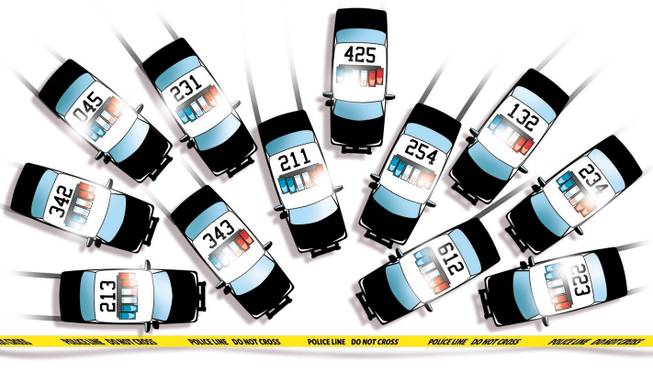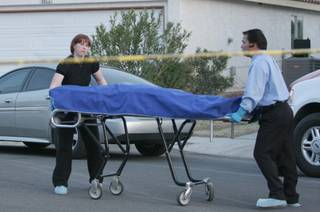Wednesday, March 11, 2009 | 2 a.m.
Murder-Suicide location
Sun Archives
Beyond the Sun
When a 444 call — officer needs help — comes across the police radio, every cop’s first instinct is to speed to the scene.
But on Feb. 28, when that call crackled over the Metro Police radio, when an officer was shot rescuing an infant from what turned out to be a murder-suicide involving the boy’s parents, most of the cops on duty that afternoon sat tight and waited for instructions.
Some officers were dispatched to the shooting, others were instructed to backfill the abandoned posts and still more were told to continue their normal police work — torture for those officers, no doubt, but a success for the department, according to Sheriff Doug Gillespie.
For the past few months his captains have been studying the department’s response protocol when it comes to major incidents. The February shooting, which happened on the Saturday of NASCAR weekend, allowed the department to test a formalized response in place of a race to the scene, Capt. Chris Darcy said.
Police supervisors monitoring the situation deliberately chose cops from different beats to respond to the incident: a 22-year-old woman held at gunpoint by her boyfriend, Allen Meister, 32, in a northwest valley home. The woman, Sulyda Pheng, managed to put her 8-month-old son on the doorstep of the home.
When Sgt. James Melton went to grab the baby, he was shot in the arm by Meister, who eventually killed Pheng before turning the gun on himself, according to police.
While a good number of police, including the department’s SWAT team, were called to the address, other officers were told to just stick to their normal patrol routines, Darcy said. And when the incident was over — Melton was not critically injured — police command staff were instructed to get officers back on their normal beats, and quickly.
“It’s really important that we have a measured response,” Darcy said. “We don’t want to over-respond and tie up all of our resources in one location.”
A handful of incidents prompted Metro captains to reexamine the department’s response protocol, though some clearly had more impact than others. The February 2006 death of Metro Sgt. Henry Prendes, fatally shot responding to a domestic violence call, has been a specter over the department. Officers working that day came from across the valley and packed the neighborhood where the shooting occurred.
Another relevant and more recent incident came up in conversations among the captains too — the late November attacks in Mumbai, India. Metro wants a measured response to serious incidents not just because police responding to one area leave another area vulnerable, but because not every incident is isolated. In Mumbai, terrorists struck multiple locations. Metro does not want to devote its resources to one area only to be ill-prepared for another problem across town, Darcy said.
Moreover, Metro does not want to “clog” officers in any one area for their own safety — in active shooter situations, crowds are a problem, Darcy said.
“We all want to help. That’s our instinct. But sometimes we need to step back and think about how we can be more effective,” Darcy said. “In this day and age, we can’t be caught short.”



Join the Discussion:
Check this out for a full explanation of our conversion to the LiveFyre commenting system and instructions on how to sign up for an account.
Full comments policy